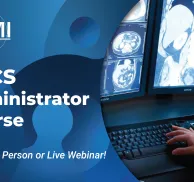If you are looking for a healthcare career that puts you on the edge of the growing need for data, then medical imaging informatics might be just the thing. Medical imaging informatics focuses on the information in medical images.
Radiology is a data-driven field that relies heavily on technology. Old school radiologists are the pioneers in imaging informatics. However, the shift to digital imaging in healthcare has led to advances in imaging informatics and expanded the need for qualified Certified Imaging Informatics Professionals (CIIP). This begs the question, what exactly is medical imaging informatics?
What Is Medical Imaging Informatics?
Medical imaging informatics is the branch of biomedical informatics that focuses on imaging. Biomedical informatics collects, analyzes, and communicates information critical to patient care. It is the interfacing of information technology and people.
Professionals in radiology informatics study image creation, processing, management, transport, storage, distribution, presentation, perception, privacy, and security. It is a career path that overlaps with many other disciplines because they generate digital medical images as part of patient care. Medical imaging informatics is unquestionably a significant and developing aspect of medicine.
How is Medical Imaging Informatics Used in Healthcare?
Health informatics is something patients have become very familiar with through patient portals, telehealth visits, and even healthcare apps. Now, healthcare professionals can use imaging informatics to further patient knowledge. For example, a doctor can pull up an X-ray on a computer screen to show not just a broken bone but the progression of recovery, so patients can see how they are healing.
Patients are often more willing to better participate in their healthcare when they can physically see a picture, such as an X-ray, of what is going on within their body. Participation might range from scheduling a follow-up visit to taking their prescription medication on a regular basis.
With this technology, providers can get digital image transfers in seconds. It will include not just an accurate image but the data that goes with it, such as patient name, diagnosis, and other critical information.
Radiologists can also collaborate with other members of a care team through virtual rounds. Linking image archiving and communication to electronic health records helps to streamline patient care on multiple levels.
What Is PACS?
Picture Archiving and Communication System (PACS) is how healthcare organizations securely store and transmit digital images like x-rays or CT scans. The use of PACS reduces the need to manually file and preserve sensitive information, films, and reports, as well as retrieve and transfer them. Instead, medical imaging goes to off-site servers, making them available virtually anywhere in the globe using PACS software, PCs, and mobile devices.
PACS and other medical imaging storage systems are becoming increasingly significant as the amount of digital medical images in the healthcare business expands, and data analyses of those images become more common.
A PACS system consists of four basic components:
- Imaging modalities—This is the imaging system used to scan a patient in order to create a medical image
- A secure network to act as the database for images
- Workstation to view and analyze images
- A secure storage area in which the image and its supporting documents live
With PACS, patient radiology reports are more orderly, and the tools allow for better image visualization.
PACS Is Now MIMPS
In 2021, the Food and Drug Administration (FDA) changed the classification's name from "Picture Archiving and Communications Systems" to "Medical Image Management and Processing System." They also changed the definition of "identification" to exclude software capabilities for "storage and presentation" of medical pictures.
These two critical changes involve:
- Software functions for storing and displaying medical images are no longer considered medical devices. The Cures Act, passed in December 2016, includes provisions that altered the Federal Food, Drug, and Cosmetic Act to exclude some software functions from the definition of a medical device.
- The name change recognizes complex image processing, such as image manipulation, quantification, and enhancements like 3D.
The FDA name and policy adjustments update the classification to include regulatory changes.
What Is RIS?
Radiology Information System (RIS) is a database that radiology professionals use to track data and files. It is typically a unique electronic health record system, usually within the Electronic Health Record (EHR), that deals with imaging and images.
By using RIS, radiology departments and imaging centers can integrate numerous operations into a single comprehensive system. With RIS, they can:
- Register new patients and do scheduling
- Manage patient flow and resource utilization
- Track patients’ location and wait times
- Gain access to documents and images from any station
- Filter out information, so the viewer sees only relevant data
- Store documents scanned into the system
- Enter additional service and supply charges as necessary
Overall, RIS improves the effectiveness of a radiology department or practice. Automating the various elements offered by RIS technology will streamline their operations, allowing for more time for patients and better accuracy.
Future of Imaging Informatics
The past few decades have seen many advances in informatics, its application, and image interpretation in general. It is hard to imagine what the next few decades will bring for this emerging sector in healthcare.
As with most industries that involve data storage and collection, imaging informatics is growing and changing all the time. Interoperability is critical to the future of healthcare, and medical imaging informatics plays a significant role. There is also a need to extract data and contextualize it for healthcare networks, clinicians, insurance providers, and other key decision-makers.
The goal is real-time information to support real-time healthcare. When physicians have immediate access to medical images and data, they can make faster diagnoses and reduce the repetition of tests and exams. This is why one future of medical imaging informatics is in AI.
What Is AI in Medical Imaging?
Artificial intelligence (AI) means computer programs able to do things and solve problems that require human intelligence and thought patterns. An excellent example of this in action is voice recognition programs like those in Apple’s Siri or Amazon's Alexa.
Healthcare systems want to enable more procedures and images for each exam for less money, which means finding ways to cut back. Health networks have to prioritize business intelligence, bots, and AI, to assist radiologists and technologists in their everyday duties so they can accomplish more with less, yet still maintain quality.
A recent study published in Current Medical Imaging found that AI-assisted CT image reading detects lung nodules and pleural effusions, reducing reading time for radiologists by more than 44%. The study indicates that the technology used in imaging informatics and AI means better patient support and faster results.
AI algorithms can operate continuously at scale while also feeding other algorithms that require more access and processing resources. The current MIMPS environment is static, but AI makes it active and offers data in real-time. Medical imaging informatics and artificial intelligence will have a significant influence on expanding the reach of our present imaging systems.
Because of artificial intelligence (AI), the cloud, developing clinical and administrative and operational demands, and the implementation of new legislation, the worldwide medical imaging informatics industry is poised for substantial growth.
Is Imaging Informatics for You?
By integrating their understanding of imaging and computer information systems, imaging information professionals contribute to the efficiency and the treatment of patients. If you have an interest in both technology and healthcare, medical imaging informatics might be the right career choice for you. It gives you a chance to be on the cutting edge of both medical data management and radiology.
Informatics-based tactics, such as the efficient use of technology and process integration, can change the work environment so that radiologists may connect with their colleagues and their job more effectively.
If you are someone interested in both science and technology to improve patient care, then this is an exciting field to consider. A place to start on your path to becoming a Certified Imaging Informatics Professional (CIIP) is with Medical Technology Management Institute’s (MTMI) PACS training course in imaging informatics. Find out more information about this and other career options on the MTMI website.








